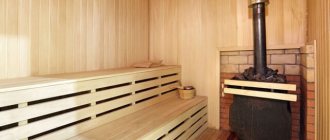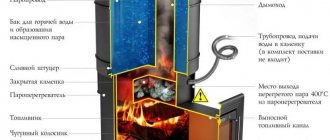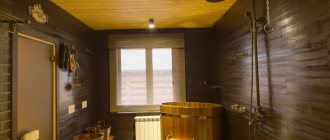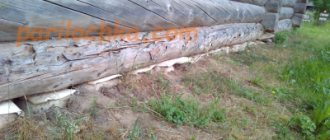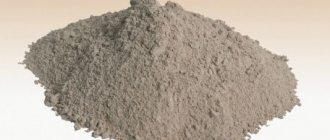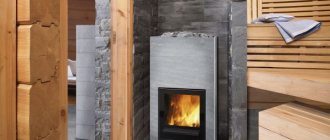Preparation for bath procedures includes heating the steam room and heating water for washing. The logical solution is to save time and combine both operations by using a wood stove as a heater and water heater. Here the user is faced with a traditional problem: he needs to choose and buy a ready-made sauna stove with a water tank, or make it himself. Let's consider the existing options for factory-made and home-made wood-burning stoves.
Who needs it?
The answer is obvious: for those who do not have a connection to the hot water supply network, and this, unfortunately, is not uncommon in our country. But in each specific case, hot water can be used for washing or for heating , or for both, therefore, for specific circumstances, stoves with different types .
In addition, in the steam room itself there is also a need for hot water - it is not good to apply cold water to the stones , because they cool sharply and may crack; then the temperature will go down, but until it rises again, that’s time. So, although small, a tank for hot water in a steam room is appropriate even if there are water supply networks.
IMPORTANT! The temperature of water that can be applied to the stones can be from 70 degrees.
Operating principle
There's nothing complicated here. Water is one of the most heat-intensive substances , so it takes a lot of energy to heat it. We can take this energy either from the stove body or from the chimney.
Brick stove for a bath with a water tank
It is clear that inside the stove there is “working” heat, which is used to heat the steam room, but in the chimney it is already considered a loss , because the gases do not have time to cool down when passing through the pipe, and in this form they escape into the atmosphere.
It follows from this that the idea of purchasing a stove for a bath with a water tank can be useful for increasing the efficiency of the stove - for this you need to take a model with a tank on the chimney.
Conclusion
In the video presented in this article you will find additional information on this topic. Also, based on the text presented above, we can conclude that the principle of making metal stoves is quite simple. At the same time, there are a lot of different designs that have their own specific features and characteristics (see also the article “Drawings of a metal stove for a bath with your own hands: how to build a heater in a steam room with high efficiency”).
Special attention should be paid to some factory products, which are presented in the form of doors, chimneys and grilles. They will significantly simplify the manufacturing process, which means it is worth developing drawings on their basis.
Did you like the article? Subscribe to our Yandex.Zen channel
Kinds
Depending on the location of the tank relative to the furnace, they are divided into the following subtypes:
With mounting tank
Wood-burning stove Zhara-Malyutka 700PU. Dobrostal Photos
The most ancient method of heating: the oven was made in such a way that on its upper surface or even a special recess was made for a container of water.
The water warmed up well, located in a container directly above the firebox . And the heater was next door to it.
Today you have at your disposal many models of stoves that allow, if necessary, to install an upper tank, which, by the way, can most often be purchased from the manufacturer at the same time as the stove.
An example is the Zhara-Malyutka 700PU oven . It is equipped with a 50-liter water tank (there is a 30-liter option).
With mounted or attached
Sauna stove with water tank - a hinged type of tank
The location in this case is the same, but the fastening may be different . Such a tank receives heat from the side wall of the furnace. At the same time, manufacturers let the owner decide on which side of the stove the water tank will be located - this is essential for baths with a small steam room space.
The side tank can either be hung on special hooks , or simply placed on a pad - heat transfer will take place in any case, but not very much.
An example is Ermak stoves, which can be equipped with mounted tanks.
With built-in
It is difficult to classify such tanks as a separate type, because in practice it is still the same container located on the side, only without the possibility of removing it. Some manufacturers continue to make similar designs. As an example, let's take the Siberia stove , which is made by NMK.
Sauna stove with water tank Kastor - built-in tank
With external
Regardless of which room the hot water tank will be placed in, the design will be the same. If all previous tanks were in one way or another in direct contact with the furnace, then this type is located at a considerable distance, so heating is carried out using a heat exchanger.
You can read about the types of heat exchangers on our website in the article dedicated to them.
Most often, remote tanks are used to not only supply the washroom with hot water, but also to heat the room in which the tank is located. By the way, there are several options:
- some prefer to take the tank to the washing room ;
- others place it in the dressing room ;
- still others are left in the steam room ;
- the fourth are taken to the attic.
If the first three differ little from each other, then the last option has functional significance. You probably know that for gravitational pressure you need to raise the water tank as high as possible . If you just hang the tank on the wall, you are unlikely to be able to wash yourself in the shower. But if you lift the tank into the attic , then washing in the shower, which is usual for a city dweller, becomes quite possible.
ADVICE! The heat loss from an uninsulated tank in the attic will be too great. Therefore, such a tank is usually lined with one or another heat insulator, maybe even with foil.
There are many examples of remote tanks. Almost every manufacturer has them .
Wood-burning sauna stoves with a tank are a remote type of tank.
With a tank on the chimney
Sauna stove with a tank on the chimney.
We have already mentioned the advantages of such tanks above. Now it's time to clarify their design. The fact is that you always have a choice: attach to the chimney a full-fledged tank of tens of liters or a small one of 5-10 liters, which will serve as a heat exchanger , that is, transfer heat further to a large tank.
Both options increase the efficiency of the furnace, but there will still be some heat loss when transferred to a remote reservoir.
Choosing boilers for the bathhouse
To maintain a stable, optimal hot water temperature, it is recommended to install equipment with cast iron heat exchangers. They heat up slowly, but maintain the desired temperature for a long time.
The following facts speak in favor of installing gas heating equipment in a bathhouse:
- Savings in fuel consumption and payment when compared with electric or solid fuel equipment.
- Environmentally friendly: no burning, no smell, no harmful emissions.
- Easy to install, configure, operate, repair.
- Electricity consumption is only 40 kW.
- Compactness.
- Simultaneous heating of the room and water.
Design and equipment of a specialized gas stove for a bath
Taking into account all these factors, we can conclude that installing a gas device is an economical and environmentally friendly solution. It is chosen taking into account the parameters of the bath and the functions it performs. A gas boiler for a bath is selected according to the following characteristics: thermal power, availability of automation, control equipment. When selecting equipment, you need to pay attention to its rated performance.
You will find detailed information about choosing a gas boiler for heating your home in our material.
Wall-mounted gas boilers for heating water
For a wooden bathhouse, you should not purchase wall-mounted equipment, only floor-mounted equipment. Since in this case the high temperature of combustion products is unacceptable. According to fire safety rules, gas boilers can be installed in a bathhouse whose room height is at least three meters. And the width of door and window openings is at least 80 cm.
If the boiler is installed individually for a bathhouse, then it is recommended to pay attention to the equipment of the latest models, which can operate on two energy sources. You can choose whether to use gas or wood. Vivid examples of such devices are: Teplodar, Uralochka, Sinara, Termofor.
Universal gas boilers for Termofor baths
Since modern equipment makes it possible to use any energy source, the choice of device depends less and less on their availability. Therefore, when buying a boiler, you should pay more attention to:
- total area of the steam room;
- quality and thickness of the furnace metal;
- heating speed and temperature;
- water tank volume;
- sizes and dimensions: pipes, stoves, tanks.
Pros and cons of different designs
Depending on the circumstances, individual advantages may outweigh the disadvantages. It is clear that if the tank is located on the stove or attached to the side , then three unpleasant things follow from this:
- Constant heating of water will lead to the formation of steam , but it will not be that steam heated over 100 degrees, which is called light - it is obtained only from overheated stones. And the usual heavy steam will pour out of the container, which makes it difficult to stay in the steam room.
- Using heated water for washing is problematic if the steam room is not combined with a steam room. You will have to carry hot water to the washroom and wash the way your ancestors washed).
- In tanks built on the side of the stove, heating occurs the worst, because the walls of the stove do not heat up as much as the top or chimney . Plus, over time, the wall of the tank itself will lose thermal conductivity due to scale, and the wall of the furnace will lose its thermal conductivity due to scale. Therefore, the water does not warm up well, remains cold at the bottom, and must be stirred manually.
such structures also have advantages they are easy to fill with water precisely because the container is not located high. But this is if there is no cold water supply either. Otherwise, the plus is leveled out.
By the way! The larger the contact area between the container with water and the oven, the faster the heating. But this is not always worth striving for - why do you need clouds of heavy steam in an unheated bathhouse?
Of course, you still have the opportunity to set up a shower from any tank. And, although stove makers do not recommend using a pump, the forced circulation of liquid in the system will calmly take water from either the manual or the attached tank. The main thing is not to forget to add more.
A pump is not needed only if gravitational and convection circulation between the heat exchanger and the remote tank is properly organized . (We recommend reading the article where the diagram is given.) But even here, if the remote reservoir is not located too high, you can only wash yourself with a hose. If you take it up into the attic, you may break the rule that says that the length of the connections should not exceed three meters . That is, everything is based on nuances and specific circumstances.
ourselves consider the optimal system to be one in which the tank is mounted on the chimney. Whether it will be a large tank or a heat exchanger depends on how you are more accustomed or comfortable to wash. Well, or whether there is a pump in the system or not.
Photo: samovar-type heat exchanger
However, the optimal system also has its drawbacks. In particular, traders admit that the connection between the tank and the pipe at the inlet below can suffer greatly from overheating, for example, in a situation where water is poured after the stove has been lit. Then the seam splits and needs to be welded. Another drawback is that the pipe burns out when the furnace heats up too much.
Pay attention to the dimensions of the filler hole . For some tanks it is large, it even has a hinged lid, while for others it is small and round. Still, you will have to fill tens of liters, and also wash the inside of the tank !
On a note! The stove should not be heated to the limit of its capabilities. This shortens the service life of the metal , which inevitably oxidizes and turns into scale, and then it crumbles and holes remain. The bottom piece of the chimney will also burn out if you heat it like this. If you don't want this, insert a piece of black structural steel pipe of the required diameter inside. It will take away some of the heat and add strength to the structure.
Useful video
This video explains in more detail about strengthening the chimney with pipe cutting:
You can learn more about the disadvantages of a hinged and chimney-mounted tank from the following videos:
https://youtu.be/S5TRvRjgmLs
How to choose the optimal design
In essence, we have already answered this question in the previous chapter, but the answer referred to the specifics of a particular bath.
Let's look at the defining points again:
How to calculate the required volume of container? Assume that one washable item requires at least 10 liters of water.
How are adjacent rooms supposed to be heated? If there are no other options, you can use a remote tank for this purpose. It goes without saying that in this case it should not be thermally insulated. Another option is to use a furnace to heat the antifreeze in a separate heating system.
Are you ready to create forced circulation? If yes, then there are no obstacles to choosing any of the described designs. In this case, you will receive not only a shower, but also, if desired, heating through radiators. True, you will have to organize the system according to all the rules.
For example, do not forget about the need to install an expansion tank , which absorbs excess fluid in the system.
Installing a gas boiler in a bathhouse with your own hands
Before connecting the equipment, it is necessary to obtain the appropriate permits and approve the project with the authorities. Develop a gas supply project in a specialized service, and then send it and accompanying documents for approval, for example, to Gorgaz. You will need papers from the manufacturer: equipment data sheet, instructions, certificate of conformity.
Work with gas equipment is carried out by specialists in accordance with accepted rules and regulations: SNiP 42-01-2002 and II-35-76, set of rules: SP-41-104-2000. They provide a detailed description of how to properly perform this work, and what is strictly prohibited from doing. For example, the diameter of the chimney is selected in accordance with the power of the device using special formulas.
Wall-mounted gas boilers for heating water
Having received the necessary permits, you can begin work: install a gas pipeline and water supply, line the wall with fire-resistant material, make a hole for the chimney.
- Flush the device's pipe systems.
- Attach wall-mounted equipment to the slats.
- Make holes in the wall, secure the planks with anchors or self-tapping screws.
- Secure the boiler to the mounting strips.
- Attach taps and filters to the pipes;
- Connect the taps at the inlet and outlet;
- Install squeegees;
- Connect the heating system;
- Connect the squeegee to the heating;
- Connect the water supply;
- Connect the chimney.
A separate room is allocated for floor equipment. The walls and floor are covered with special fireproof materials. The unit is screwed to the floor. The rest of the connection diagram is identical to the wall-mounted version.
How to install a wood stove with a tank
If the stove is not homemade, then the details of its installation are described in the passport . Just in case, let us remind you that there is a significant difference between preparing to install a metal stove and laying brick.
Stove for a water bath: heat exchanger on a pipe
In the first case, a relatively light foundation is made, without a separate foundation , which is designed to ensure both stability and fire safety. These are 1-3 rows of bricks that are laid below the finished floor level.
refractory sheet is placed on top of the base , followed by an iron sheet that protrudes significantly in front of the firebox to avoid fire from flying sparks.
If the firebox is remote , then the duct is routed through the wall and must be thermally insulated. a gap is left between the channel and the wall , where a heat insulator is inserted (not any, but only one that can withstand very high temperatures). The wall itself is made of non-combustible material, for example, brick. Read more about remote fireboxes here; you may also need material about portals and fireplace stoves.
After installing the stove (see here and here), the chimney is installed. This is a separate topic. We are only interested in the case when the tank is located on the chimney. There is already a chimney pipe inside it , so it is simply placed on the outlet section of the pipe from the stove , and a regular chimney is mounted on top.
In other cases, the tank is either placed/hung on board, or pipes/hoses are attached heat exchanger a remote tank fixed in the washing room or dressing room.
Installing the tank should not cause much difficulty, especially when it is not a remote model. The hinged one, as the name suggests, is simply hung with hooks on the side of the stove , the mounted one is placed on top . The chimney tanks are simply placed on the outlet piece of pipe from the stove. For greater reliability, it is worthwhile to provide a stronger mount if you do not want to drop a tank weighing half a centner, or even more.
The remote tank may have loops for wall mounting : watch the short video where they are shown.
Making a steel stove-stove
The construction of a homemade sauna stove with a built-in heater and water tank is shown in the drawing. The design is quite simple - the body of the heat generator, made of an iron pipe, is divided into 4 compartments - an ash chamber, a firebox, a heater and a water heating tank. At the bottom of the firebox there are grates, between the remaining sections there are metal partitions crossed by a chimney.
The following materials will be used to manufacture the heater:
- pipe with a diameter of 400-500 mm;
- sheet metal 3 and 5 mm thick for partitions;
- fittings or corners for the grate;
- pipe Ø10-15 cm for the chimney.
Advice. For the body, it is advisable to find a thin-walled pipe (3-5 mm), since standard rolled metal with a wall thickness of 8-10 mm will be too heavy. The height of the stove can be adjusted due to the size of the heater, tank and firebox.
The procedure for assembling a heat generator with an integrated tank:
- Align the ends of the pipe with a grinder, cut openings for loading hatches and doors. Treat sharp edges.
- Place the cut pieces of metal on the doors - clean the edges, weld the handles and hinges.
- Make round partitions with holes for the flue. Make the firebox vault from 5 mm thick steel, the remaining covers from 3 mm sheets.
- Weld the grates from reinforcement Ø12-18 mm or angles No. 4-4.5.
- Mount all workpieces according to the drawing. Clean the welding seams and check for permeability using kerosene.
Equip the tank located on top with a convenient lid, cut a fitting into the bottom of the container and install a drain valve. It is better to reinforce the junction of the chimney and the firebox roof with stiffening ribs made of metal triangles, since this place burns out first. How to properly make such a stove, see the latest video:
Safe Operation
We have already mentioned the danger of the tank installed on the chimney overturning if it is not secured additionally.
It is equally important to observe the following rules for operating a water heating system:
IMPORTANT! Check the presence of water in the system before starting to light the stove. At least in this case, you can count on longer operation of the equipment.
In winter, the rule about draining water in the system becomes especially relevant:
DANGER! Drain the water before leaving to prevent it from freezing and bursting the pipes.
Well, don’t neglect the following advice:
ADVICE! Joints and connections are the most unreliable places in any structure, so they require good insulation and constant attention in the future.
Fight heavy steam by filling the tank half-full so that you can then add cold water to eliminate the steam.
Positive and negative qualities of metal sauna stoves
There cannot be a steam room without a stove, because it is it that heats the room and maintains the desired temperature. Nowadays you can find a wide range of different options. But it’s best to make the oven yourself.
The advantages of a metal device include:
- actions are carried out quickly, and at the same time not very expensive, this can be done autonomously with basic knowledge and experience;
- a significant part of the models are compact, so they are suitable for small saunas;
- rapid heating of the steam room to the required temperature, even in winter;
- the mechanism can last a long time, it all depends on the welding condition and the thickness of the metal;
- economical fuel consumption;
- easy to use, even a person who does not have the proper skills can handle it.
An iron stove has negative qualities, these are:
- low heat capacity, it is not enough to heat the rest room;
- excessively rapid cooling, so you need to heat it regularly;
- the walls heat up and nearby objects can catch fire.
It is not easy to determine which stove is best for a bath; there are a lot of design qualities.
How to install brick ovens with a water tank
Brick sauna stoves with a water tank can have different designs. The general thing is that the tank is located either above the firebox or on the side of it, next to the heater. a protrusion of appropriate size is made under the tank, which has a rectangular shape .
For independent work on the construction of a brick kiln, you need experience . The “recipe” may seem simple, but this simplicity is deceptive. Read more about brick kilns here.
It all starts with choosing a design , and there are quite a few of them. When the choice is made and the orders are found (for example, on the Internet), the number of bricks and the weight of the stove with all its components are calculated - the depth of the foundation depends on this parameter. If the weight of the finished stove is more than 700 kg (and it will definitely be more and do not forget to include a tank filled to the top with water), then a foundation is automatically required . Read about how foundations for furnaces are made on our website.
Having prepared the base, you can begin laying. But first you need to prepare the right solution .
IMPORTANT! Cement mortar is not used for laying stoves. Only clay and sand. There is also masonry without mortar.
First you need to soak the clay. To do this, take equal amounts of water and clay and mix them. After a couple of days, wipe the solution through a fine grid (3x3 mm is good). Then take the sand , sift it and add it to the mixture so that you get something like thick sour cream. The masonry mortar should be neither too fat nor too thin.
Alternatively, you can buy a ready-made clay-sand mixture in bags at a hardware store; just dilute it with water and you can lay the stove (follow the instructions on the bag).
The masonry itself follows the order of the chosen furnace design . You will need two types of bricks: regular solid and fireclay . To help those who decide to do it themselves, we have selected a video where the essential nuances are explained (the voice is boring, but you can be patient):
We also recommend useful materials about stoves:
- Installation in a steam room and a protective screen;
- Inexpensive;
- Which is better;
- With a steam generator.
***
Well, the topic is covered sufficiently fully so that you can decide on the choice of the right type of tank, its volume and location. Good luck with the installation!
Advantages of wood-burning sauna stoves
Wood-burning sauna stoves have a number of undeniable advantages; you will understand more than once that you have made the right choice, because:
- A sauna with such a heater can be built anywhere and heated at any time, since it operates autonomously and does not depend on power supply. Do not be afraid of possible interruptions in the power supply - a wood-burning heater will not let you down under any circumstances. This is especially true for suburban dacha plots, where fuel can be found in any copse.
- Fuel for a wood-burning stove is not in short supply and has a very affordable price, even if you decide to purchase high-quality firewood specifically designed for a bathhouse. Firewood for a sauna must be well dried, only then can the desired effect of creating a healthy sauna microclimate be achieved.
- A wood-fired stove will heat the stones faster than an electric one.
- Firewood, when used in a bathhouse, is a safe and environmentally friendly fuel.
- Burnt and smoldering firewood retains heat in the stove for a long time, and therefore heat in the room, while an electric stove cools down much faster, almost immediately after the power supply is cut off. A stove heated with wood remains warm for up to 12-14 hours, especially if it is made of regular brick, which also cools slowly and helps retain heat internally.

